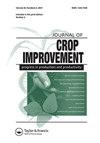Antifungal potential of endophytic Bacillus species isolated from tomato (Solanum lycopersicum) against Fusarium oxysporum collected from selected farms in Nigeria
IF 1.5
Q3 AGRONOMY
引用次数: 2
Abstract
ABSTRACT Fusarium wilt, caused by F. oxysporum, is a prevalent destructive tomato (Solanum lycopersicum L.) disease in Nigeria. Development of safe, and efficient biocontrol measures is important in the management of the disease. In this study, incidence of fusarium wilt of tomato in four agricultural zones of Oyo State was established through purposive sampling, and the abundance, and in vitro-biocontrol potential of Bacillus endophytes were determined. Strains of F. oxysporum and Bacillus endophytes were isolated from tomato plants collected from 21 farms. In vitro-inhibition potential of endophytes was determined through a modified, dual-culture assay, involving six endophytes, and carbendazim (fungicide), set up in a completely randomized design. Using a rating-scale of 0–9, the highest wilt severity (6.67) and incidence (39.30%) were observed on Akinware farm in Ibadan/Ibarapa agricultural zone of Oyo State. Fusarium oxysporum IB3q caused severe wilt symptoms, including leaf chlorosis, necrosis, vascular discoloration, and wilt, on infected Alausa and Ibadan-local tomato varieties. Thirty-nine strains of Bacillus endophytes were isolated from the tissues of healthy tomato plants. Six of the isolated Bacillus endophytes inhibited F. oxysporum. Bacillus amyloliquefaciens Sa08 and B. subtilis Og04 had inhibitory zones of 15.67 and 19.43 mm, respectively, against F. oxysporum, and caused hyphal disintegration of the pathogen. They produced cell wall-degrading enzymes, with relative activities ranging from 0.87 to 5.04. Based on their in vitro-inhibition potential, B. amyloliquefaciens Sa08 and B. subtilis Og04 should be deployed, as prospective biocontrol measures against seed-borne fusarium pathogens and fusarium wilt on tomato plants.从番茄(Solanum lycopersicum)中分离的内生芽孢杆菌对从尼日利亚选定农场采集的尖孢镰刀菌的抗真菌潜力
摘要镰刀菌枯萎病是由尖孢镰刀菌引起的一种在尼日利亚流行的破坏性番茄病。制定安全、有效的生物控制措施对该疾病的管理非常重要。本研究通过有针对性的采样,确定了奥约州四个农业区番茄枯萎病的发病率,并测定了内生芽孢杆菌的丰度和体外生物防治潜力。从21个农场采集的番茄植株中分离出尖孢镰刀菌和内生芽孢杆菌菌株。通过一种改良的双培养法测定了内生菌的体外抑制潜力,该法涉及六种内生菌和多菌灵(杀菌剂),采用完全随机设计。使用0–9的评分表,在奥约州伊巴丹/伊巴拉帕农业区的Akinware农场观察到最高的枯萎病严重程度(6.67)和发病率(39.30%)。尖孢镰刀菌IB3q在受感染的阿劳萨和伊巴丹当地番茄品种上引起严重的枯萎症状,包括叶片失绿、坏死、血管变色和枯萎。从健康番茄植株组织中分离到39株内生芽孢杆菌。6株分离的内生芽孢杆菌对尖孢镰刀菌有抑制作用。解淀粉芽孢杆菌Sa08和枯草芽孢杆菌Og04对尖孢镰刀菌的抑制区分别为15.67和19.43mm,并导致病原体的菌丝崩解。它们产生细胞壁降解酶,相对活性在0.87至5.04之间。基于其体外抑制潜力,应采用解淀粉芽孢杆菌Sa08和枯草芽孢杆菌Og04作为番茄种子传播镰刀菌病原体和枯萎病的潜在生物防治措施。
本文章由计算机程序翻译,如有差异,请以英文原文为准。
求助全文
约1分钟内获得全文
求助全文
来源期刊

Journal of Crop Improvement
Multiple-
CiteScore
3.30
自引率
7.70%
发文量
42
期刊介绍:
Journal of Crop Science and Biotechnology (JCSB) is a peer-reviewed international journal published four times a year. JCSB publishes novel and advanced original research articles on topics related to the production science of field crops and resource plants, including cropping systems, sustainable agriculture, environmental change, post-harvest management, biodiversity, crop improvement, and recent advances in physiology and molecular biology. Also covered are related subjects in a wide range of sciences such as the ecological and physiological aspects of crop production and genetic, breeding, and biotechnological approaches for crop improvement.
 求助内容:
求助内容: 应助结果提醒方式:
应助结果提醒方式:


